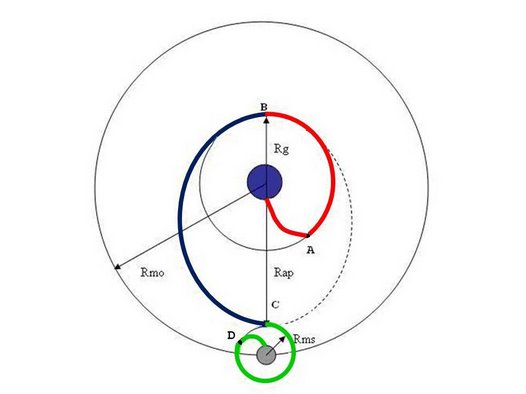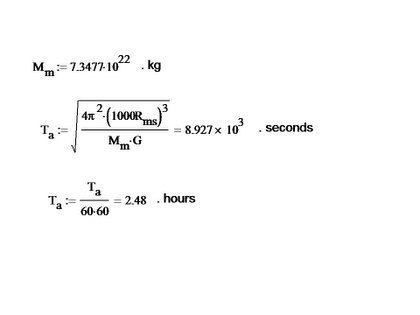A small base station will be deployed on the moon, to serve as a relay point between the rover and the Earth. This configuration will avoid the use of a satellite, which will reduce the complexity of the overall design and reduce the cost. Compared to a relay satellite, the base station on the Moon will have the same communications equipment, but it will not need course correction hardware/software, or station-keeping hardware and fuel.
The deployment of the moon base station and the rover will be done in three stages, departure stage, transfer stage, and arrival stage. Orbital parameters of the moon are given below.
|
Semi-Major Axis |
384,748 km |
|
Perigee |
364,397 km |
|
Apogee |
406,731 km |
|
Mean Eccentricity |
0.05490 |
|
Mean Inclination |
5.145o |
|
Mean Obliquity |
6.688o |
1. Departure stage
The figure below shows the path from the Earth to the moon. The departure stage, transfer stage, and arrival stage are respectively represented in red, blue, and green.

Figure 1. Path from the Earth to the Moon.
The vehicle (containing both the moon station and the rover) will be launched from Cape Canaveral, FL. Since this location is near the equator, the velocity of the earth’s rotation will help the vehicle reach the initial track. This first orbit will be a geosynchronous orbit around the Earth. This orbit will have a radius of 42,164 km and an inclination equal to the inclination of the moon’s orbit, 5.145o. At point A, course correction rockets will fire up and will launch the vehicle into the geosynchronous orbit. A full revolution around this orbit will take one day, but the launch time can be controlled so that the time it takes the vehicle to reach point B can be known. We will assume this time is half a day.
2. Transfer Stage
Once the vehicle reaches point B, the rockets will fire up again, transferring the spacecraft from the circular geosynchronous orbit to an elliptical transfer orbit (marked in blue in Figure 1). Since the vehicle is already on the orbital plane of the Moon, no further inclination changes are needed. The time the vehicle will spend in this transit orbit can be calculated as follows:
Re: Radius of the Earth
Rm: Radius of the Moon
Rg: Radius of geosynchronous orbit
Rmo: Radius of the Moon’s orbit (apogee)
Rap: Distance to apogee of transit orbit
Rms: Radius of orbit around the moon


3. Arrival Stage
When the vehicle reaches point C, rockets will fire up once more to transfer it to a circular orbit with a radius of 2,147 km around the moon. The spacecraft will remain on this orbit until it reaches point D. Once at point D, a capsule containing the soft-landing gear (parachutes, airbags, retro-rockets, etc) will separate from the vehicle and head towards the moon’s surface. The time it takes to complete this stage is:

Overall, the equipment will spend half a day in the departure stage, about 6 days in the transfer stage, and under three hours in the arrival stage. The total time needed to deploy the equipment on the moon is close to seven days.






